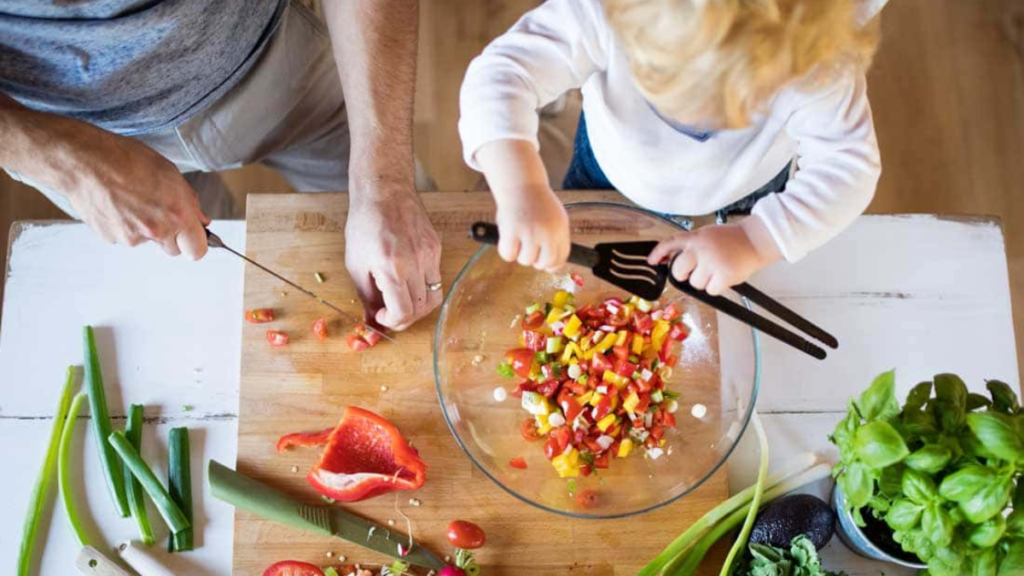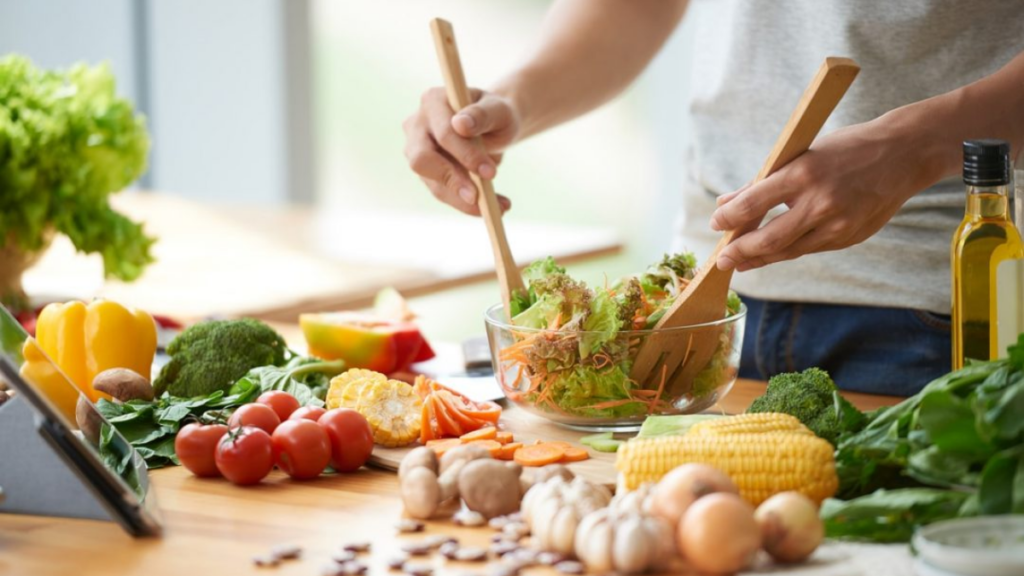Cooking healthily does not necessitate becoming a gourmet chef or purchasing expensive cookware. Basic culinary skills can be used to make healthful meals. Saturated fats can be reduced by utilizing healthy cooking practices. Take, for example, the fact that many frying fats, such as butter and lard, are high in saturated fats. Adults should consume no more than 10% of their total daily calories from saturated fat. A 2,000-calorie diet means no more than 200 saturated fat calories per day (approximately 22 grams). By moving to roast, you avoid adding fat to the dish, enabling any fat in the food to seep away.
There are numerous approaches to making meals healthy. Limit your intake of fats, sweets, and salt while increasing your intake of vegetables, fruit, grains, lean meats, and low-fat dairy. Foods that contain extra fats, sugars, or salt are less healthful than foods that contain these ingredients naturally.
What Do You Understand By Healthy Cooking?
Healthy eating can imply a variety of things. It’s as simple as putting a healthy dinner on the table for some of us, and others believe it means adding more low-carb or plant-based foods to our weekly menus. Whatever method you choose, you’ll need a few go-to recipes, and nothing beats a collection of tried-and-true favorites.
There are many delicious dishes in this collection of 50, but a lightened-up spin on a classic chicken marsala is terrific if you’re looking for a place to start. This meal, smothered with sauteed mushrooms and sundried tomatoes, is nutritious and filling. A small amount of butter in the sauce goes a long way – just a dab gives creamy richness.
Tips for Healthy Cooking
Here are some tips for healthy cooking:
Make a Plan
It’s easy to get stuck for supper ideas if you don’t have a plan (or breakfast or lunch, for that matter). For some people, meal planning entails creating a thorough menu and shopping list on Sunday to be prepared for the entire week. Others may see taco night, pasta night, or stir-fry night as scribbles on a sticky note. Whatever your method, having a strategy can help you figure out what you will make and ensure your success.
Eat More Fruits and Vegetables
Only 14% of Americans consume the required quantity of veggies, while only 18% consume enough fruit. That means more than 80% of us aren’t getting enough fruits and vegetables! Antioxidants, vitamins, minerals, and fiber are abundant in fruits and vegetables, all of which help to reduce inflammation. Every day, we should have 2 cups of fruit and 2.5 to 3 cups of veggies (adult men are on the higher side for veg). (Here are eight different ways to get the daily recommended amount of fruits and vegetables.)
When it comes to cooking, make produce the star of your show. Make a fruit smoothie for breakfast, a large salad for lunch, and spaghetti squash stuffing for dinner. Spiralize zucchini or sweet potato to make veggie noodles. Make half of your plate fruits and vegetables. Snacks, such as baby carrots, apple slices, dried fruit, or vegetable soup are terrific for getting extra produce servings.
Choose Whole Grains
At least half of the time, choose whole grains over refined grains. Whole grains, such as brown rice and bulgur, have more fiber, B vitamins, magnesium, zinc, and other minerals because their bran is still intact. Quinoa, whole-wheat pasta, oats, farro, and barley are great as side dishes, salad toppings, and soup ingredients.
Mix Up Your Protein
Meat is an excellent source of protein, yet it is frequently given in substantial portions. A serving of protein is about the size of a deck of cards and is 3 ounces cooked or 4 ounces raw. As a result, eat less meat, fish, and poultry. Fill the rest of your dish with fresh fruits, veggies, and whole grains. It doesn’t have to be meat, either. Several vegetarian proteins and vegan protein-rich foods are a fantastic way to supplement your diet with more plant protein.
Cook With Global Flavors
Some of the healthiest diets, such as the Mediterranean diet or traditional Japanese or Chinese cuisine, emphasize vegetables and grains while avoiding processed foods. Spices and herbs, such as curry powder and basil can enhance the flavor of your cuisine without adding salt. Plus, dishes like Thai curries and Greek salads are not only healthy but also delicious (and not too difficult to prepare at home!).
Add Healthy Fats
Fat is not a terrible thing. Despite new data debunking the idea that low-fat diets are the healthiest, many people still believe fat is bad. Fat is filling (so if you eat less of it, you may not be satisfied after your meals). It also aids in absorbing minerals such as vitamins A, D, E, and K. It also tastes great! Unsaturated fats (e.g., olive oil, avocados, almonds) should be preferred over saturated fats (e.g., butter).
Limit Added Sugar and Salt
Every day, most of us consume more added sugars and sodium than is suggested. Over time, overeating can put you at risk for health problems such as high blood pressure and heart disease. If you’re a woman, limit yourself to 6 teaspoons of added sugar each day, and if you’re a guy, limit yourself to 9 teaspoons. White sugar, brown sugar, honey, and maple syrup are examples. When cooking, read product labels carefully and use sweeteners sparingly.
What Cooking Method is the Healthiest?
Here are some of the best cooking methods for a healthy meal:
All of these are the healthiest meal options. You may make your meal healthier by using all of these cooking methods. Because a good meal is so crucial for our health, everyone should recognize its importance and always use the best.
Why is Healthy Cooking Important?
Our food and cooking choices significantly impact our health and well-being. The way you cook is a fantastic place to start if you want to improve your health and fitness. You should prioritize healthy cooking if you want to eat healthier as part of your lifestyle adjustments.
Here are the top five science-based reasons why you should start focusing on healthy cooking to
support your health and immune system.
- A balanced diet is recommended by healthcare practitioners and experts for various health benefits, including a lower risk of obesity, diabetes, cardiovascular disease, and dementia, among others. Despite awareness, there are various challenges to following a balanced diet, one of the most significant being a lack of cooking abilities.
- According to studies, home cooking is an essential component of a balanced diet. People who make their meals at home more frequently eat healthier than those who do not. Experts claim that people who cook their food at home consume fewer carbs, sugar, and bad fats than people who do not cook at home, even if they are not trying to lose weight.
- Obesity is one of the leading causes of chronic illness, and healthy cooking helps to avoid it. Outside meals are typically high in calories, harmful fats, and sweets, causing the body to gain weight, wear down the bones and organs, and deprive the body of essential nutrients.
- Fresh fruits and vegetables are the foundation of healthy nutrition, and thus healthy cooking emphasizes their use. When you cook at home, you may select recipes that include colorful, green vegetables and reap the benefits of their nutrients. Cooking at home also allows you to experiment with new vegetables.
How to Boost Flavour of Your Recipes in a Healthy Way?
Creating meals with herbs, spices, and other natural flavorings is one of the best ways to add color, taste, and aroma to foods without adding salt or fat. Healthy flavor boosts include:
- Fresh herbs. Choose herbs that look bright and aren’t wilted, and add them toward the end of cooking.
- Dried herbs. Add pinches of dried herbs in the earlier stages of cooking. But avoid prepackaged seasoning mixes because they often contain a lot of salt.
- Dried mustard. Used sparingly, dried mustard adds a zesty flavor while cooking.
- Vinegar or citrus juices. Add them at the last moment. Vinegar is excellent on vegetables, and citrus works well on fruit such as melons.
- Marinades. Try a low-fat marinade for broil, grill, or roast foods. To make your marinade, use 1 part oil to 2 parts vinegar or citrus juice, and add herbs and spices as desired.
- Fresh hot peppers. Remove the membranes and seeds first, and then finely chop the peppers. A small amount goes a long way.
- Dried vegetables and fruits. Some vegetables and fruits — such as mushrooms, tomatoes, chilies, cherries, cranberries, and currants — have a more intense flavor when dried than when fresh. Add them when you want a burst of flavor.
Conclusion
Cooking correctly allows you to consume a well-balanced, nutrient-dense meal that keeps you healthy and helps you manage your weight. The friendly, healthy ingredients you use to produce your meals are the foundation of healthy cooking. Implementing tried-and-true health ideas that help you live and cook healthier is a must to practice healthy living every day. Cooking your meals is a fantastic place to start when eating healthier, but it doesn’t always equate to “healthy.” Eating healthily is all about knowing what you’re eating and preparing a well-balanced meal. We don’t like to leave anything out entirely because we believe that eating healthy doesn’t have to imply deprivation. But keep in mind that everything should be consumed in moderation!


